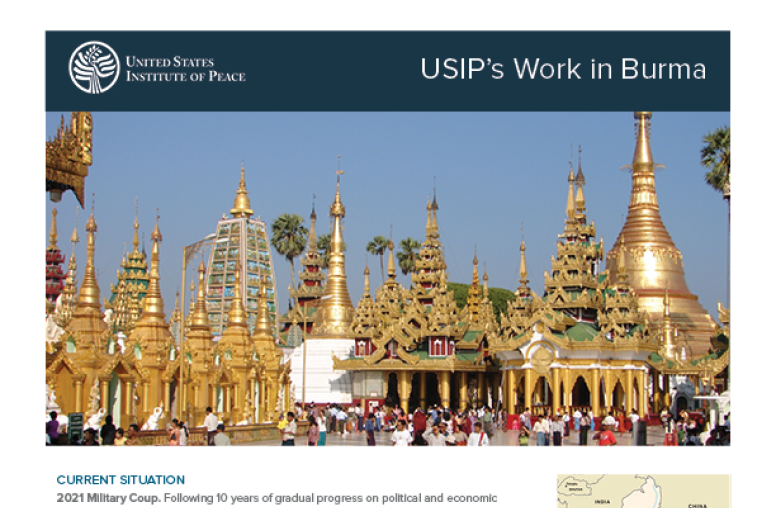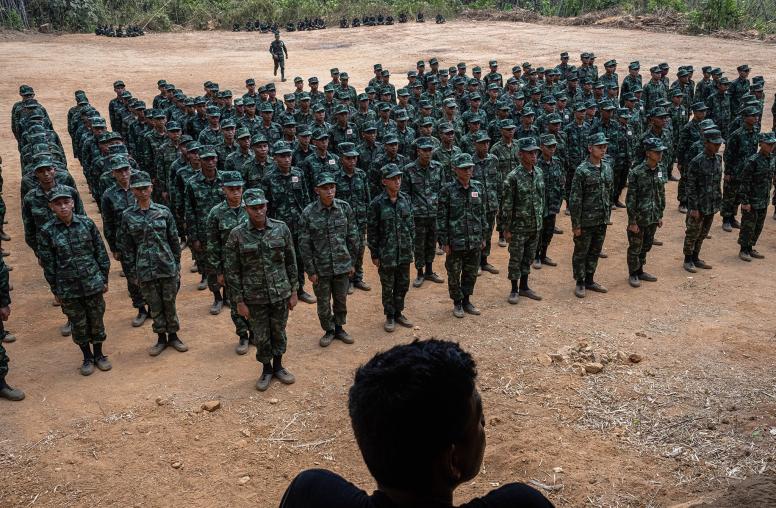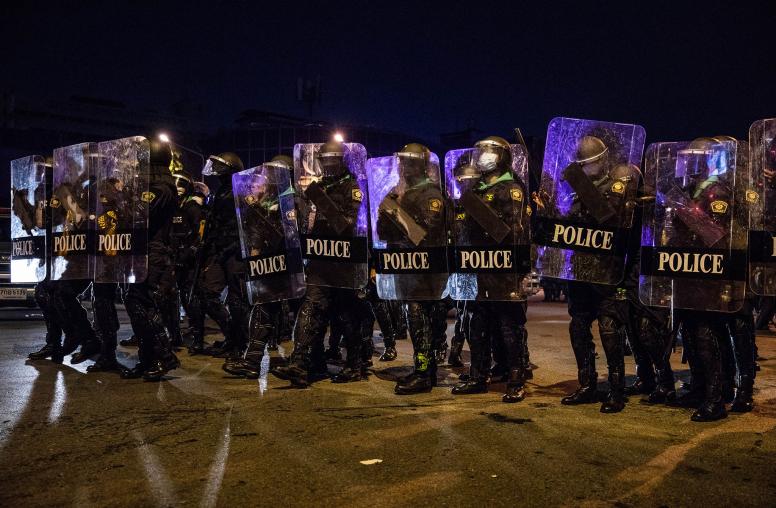Myanmar’s Collapsing Military Creates a Crisis on China’s Border
With China taking bolder steps to shape the trajectory of the conflict, other countries remain aloof.
Operation 1027 — an offensive launched in October 2023 by an alliance of three ethnic armed organizations (EAOs) against the military junta in Myanmar — has disrupted hundreds of forced labor scam syndicates operating under the protection of Myanmar’s army, dented the army’s image of invincibility and decimated the lucrative China-Myanmar border trade. A second operation launched on March 7 by another EAO in Kachin State has compounded China’s economic woes by adding to the impact on trade.

Together, these operations have severed China’s links to the Indian Ocean, imperiled a geostrategic oil and gas pipeline project, and triggered action by China’s People’s Liberation Army, which has conducted live-fire exercises in southwestern Yunnan Province on the border with Myanmar. As China scales up its efforts to influence the trajectory of the conflict in Myanmar, concerns increase that this will dim the prospects for democracy and generate greater challenges for other countries.
Myanmar’s Army Loses Ground
While there is overwhelming evidence that China had advance knowledge of, and supported, Operation 1027 with the goal of addressing rampant criminality on its border, the outcome of the offensive is also increasingly seen as hurting Chinese interests.
Between October 2023 and January, the Three Brotherhood Alliance (3BHA) — comprising the Myanmar National Democratic Alliance Army (MNDAA), Arakan Army (AA) and Ta’ang National Liberation Army (TNLA) — seized control of more than 20,000 square kilometers of territory, including vital positions along the China-Myanmar pipeline project. As a result, locations of critical infrastructure in Rakhine State and the entry point into China at Muse have turned into flashpoints between the belligerent parties. Myanmar’s army no longer has a monopoly over the provision of security to geopolitically and economically vital infrastructure. And the army’s loss of land ports critical to cross-border trade with China, including the port city of Chinshwehaw, is costing Chinese businesses millions of dollars in lost trade per day.
Coercive Chinese Mediation
Its interests at risk, China moved quickly in December of 2023 to take on an unfamiliar role of attempting to mediate the conflict in Myanmar. Between December 2023 and March, China brokered four rounds of talks between the 3BHA and Myanmar’s army that helped tentatively freeze the conflict in Northern Shan State. The initial rounds of talks focused on stabilizing the China-Myanmar border, with China attempting to persuade Myanmar’s army to peacefully hand over the Kokang territory to the MNDAA in exchange for the 3BHA halting its offensive and permitting the safe passage of the Myanmar army’s troops. In an attempt to pressure Myanmar’s army into accepting this arrangement, China issued arrest warrants for the army’s border guard force (BGF) leaders — individuals that the army relied on to defend Kokang — in the midst of initial rounds of talks in the second week of December.
Despite this pressure, Myanmar’s army did not comply and the 3BHA resumed its offensive after the negotiated deadline for the army’s withdrawal from Kokang passed on December 31. On January 5, Myanmar’s army, overpowered and under pressure from China, surrendered to the MNDAA. This setback severely eroded the army’s image of invincibility and triggered a crisis within the military’s leadership over responsibility for the defeat.
Peng Deren, the commander in chief of the MNDAA, noted that the army’s defeat in Kokang had “crushed the myth that the Myanmar army is invincible.” It revealed to the army’s foes and Myanmar’s neighbors the weakness of what many had otherwise thought to be one of the region’s most powerful armies.
The Haigeng Agreement
With the military’s surrender of Kokang likely to embolden the resistance, China stepped in more forcefully, using leverage gained over the MNDAA as it took over Kokang to coerce the 3BHA and the military to agree to a cease-fire on January 11. Named after the lakeside park in Kunming where the talks were held, the Haigeng Agreement effectively froze the conflict in Northern Shan State along China’s border by stipulating that the military forgo airstrikes and heavy artillery attacks on positions held by the 3BHA as of January 12 in exchange for the 3BHA stopping its offensive in the state. Myanmar’s army and the 3BHA also pledged to collectively safeguard Chinese investments, businesses and nationals in Myanmar.
The Haigeng Agreement has three important implications. First, the agreement only applies to four parties — the 3BHA and the army — in Northern Shan State. It does not ensure the stability of the whole of the border area, nor does it halt military actions of other parties. Second, the agreement was useful for the MNDAA, as preventing junta airstrikes enabled the EAOs to return to Kokang more than 50,000 internally displaced persons who had been displaced into the Chinese-speaking United Wa State Army’s (UWSA) territory. It also opened the possibility that China might resume electricity and internet connectivity in Kokang, and enabled the MNDAA to begin governing Kokang and collecting taxes. Third, the agreement gave the military the opportunity to regroup in Northern Shan State, and to avoid the immediate loss of its remaining positions in Muse and Lashio, which are fully surrounded by the 3BHA.
Economic Woes and the Need to Resume Trade
While the Haigeng Agreement has held in Northern Shan State, by early March pressure started building in China’s Yunnan Province where prospects for trade remain bleak. According to the 2024 work report of Lincang City, the sub-provincial government that administers the territory bordering Kokang, local party officials aim to increase trade by 15%, investment by 12% and to achieve GDP growth of 7%. Other governments across Yunnan Province aim to achieve similar goals, but none of them will manage this unless they are able to restart trade with Myanmar.
The need to restart cross-border trade coupled with rapid junta losses in Rakhine State prompted China to launch a new round of negotiations in early March with the goal of compelling the 3BHA and the military to establish trade cooperation, and pressuring the 3BHA and the military to freeze the conflict in Rakhine State. China failed to accomplish these goals largely due to the military junta’s unwillingness to make any meaningful concessions to the 3BHA.
Myanmar’s Army as a Junior Partner
While the March talks came close to achieving a deal, a key obstacle related to demands raised by both the Chinese and Myanmar’s army that the port of Chinshwehaw, bordering China’s Yunnan Province and critical to the flow of trade from Myanmar to China, be managed by national-level entities. While the MNDAA attempted to make the case that it is a federal-level EAO and can manage the Chinshwehaw port on its own, Myanmar’s army insisted not only that the State Administration Council’s (SAC) Ministry of Commerce should manage the port, but that army personnel would need to be deployed to secure trade.
For the MNDAA, which had just liberated its territory from the military, this was a nonstarter. A leaked version of the proposed deal indicated that Myanmar’s army was willing to go as far as accepting a role as junior partner in terms of the share of the trade benefits, offering the MNDAA 70% of the customs and tax fees on trade. Neither party was happy with the deal, and while it was announced on March 4 that a consensus had been reached, no details were made available, purportedly as the Chinese side had demanded the parties keep them confidential. Surprisingly, on March 5, the Kachin Independence Army (KIA), which together with the 3BHA make up the Northern Alliance, leaked the details of the agreement, which sparked a strong reaction from Myanmar’s army. The army was likely humiliated that the draft agreement gave it “junior” status vis-à-vis trade revenue. This made the prospects of a deal much less likely, once again causing frustration for China. This frustration was undoubtedly compounded by the lack of interest from the parties in expanding the Haigeng Agreement to cover Rakhine State.
Operation 0307
Just four days after leaking the details of the agreement, the KIA launched Operation 0307, which has focused on systematically ejecting Myanmar’s army from the KIA’s traditional control areas, especially along the China border and the strategically important Bhamo-Lweje Road. The timing of the KIA’s move was strategic for two reasons: (1) with the trade talks ongoing, the KIA saw a strategic opening to capture control over the lucrative border trade in a move that might benefit the KIA, and which also might help increase Chinese leverage over an even weaker military when talks resume in April, and (2) the KIA had become increasingly concerned that all of the other northern EAOs had taken vast territories, and pushed the military out of their spheres of influence, while the KIA remained encircled.
Operation 0307 has proven to be no less successful than Operation 1027. In just four weeks, the KIA captured over 60 military positions, pushing the military out of its key territories around Laisin and Laiza; has taken a key border town adjacent to China’s Zhangfeng border crossing; and has brought over 2,000 square kilometers of territory under its control. This has further complicated the situation along the China-Myanmar border, resulting in China losing connectivity along nearly all key border crossings. In a sign of desperation, China’s Dehong Prefecture began rerouting goods via airfreight to Yangon in early April, which has most certainly resulted in a major increase in the cost of transportation.
An Increasingly Complex Border
While China has been focused on trying to reshape relations between Myanmar’s army and the 3BHA, much more serious developments are underway in northern Myanmar, which Beijing has largely ignored. These include two key trends. First, the EAOs are exhibiting a preference for dealing with Myanmar’s opposition National Unity Government (NUG) as they push the military out of the borderlands. While the MNDAA has refused to permit Myanmar’s army from having boots on the ground in its territory, it has no such hesitation regarding the NUG and its key allies. Throughout Operation 1027, a contingency of the Karenni National Defense Force was stationed in Kokang and fought alongside the 3BHA.
Meanwhile, the MNDAA hosted the NUG’s minister of defense in its territory in February, raising questions as to whether the NUG and MNDAA might announce a deal to jointly manage border trade. Second, rivalries among rising powers are growing. In March, hostilities erupted between two of the most powerful of the EAOs — the UWSA and MNDAA — around an incident involving UWSA officials entering MNDAA territory. The incident resulted in violence between the two armies and a harsh exchange that culminated in the MNDAA going as far as to tell the UWSA that it will “no longer play the role of the little brother to the UWSA.” This was followed by tensions between the Northern Shan Army and MNDAA, which fought a battle over territory contested between the two parties. Similar tensions have flared between the TNLA and both the North and the South Shan Army, and between the KIA, TNLA and MNDAA. In many respects, this should be expected given the dramatic shift in territorial control, and the growing relative power of the 3BHA vis-à-vis the other northern EAOs and the weakening military.
These dynamics point to a major need for support to processes that might help these parties establish effective mechanisms to de-escalate conflict, and to ultimately work toward building consensus between them regarding the country’s future. China’s focus on immediately resetting trade by pushing some of these parties to deal with the junta does nothing other than create further complications vis-à-vis this need.
International Implications
China has emerged by far as the party most actively involved in attempting to shape the trajectory of the conflict in Myanmar. It is currently focused mainly on achieving this through coercive mediation, but this could potentially change as China’s efforts are frustrated. In early April, China launched major military exercises along the border with Kachin State, signaling a redline in terms of instability along the border. Meanwhile, Chinese policy advisors linked to China’s state-owned proponent of the Kyaukphyu Port project have begun to make public calls for China to deploy a robust security presence in Myanmar to protect its interests. Chinese state media personalities have even hinted at the idea that the People’s Liberation Army is prepared “if [Myanmar’s junta chief] Min Aung Hlaing’s government can’t handle the situation.”
The lack of other states getting their hands dirty and supporting solutions on the ground gives China the space to focus its interventions on enhancing its interests rather than working toward long-term peace. This has significant implications in terms of the interests and incentives of the anti-junta forces on the ground. In the absence of robust international support, resistance actors, including the NUG, are navigating further into China’s orbit, as can be seen by positions that the NUG has taken vis-à-vis China on key political questions. This gives EAOs presently in China’s sphere of influence, and which largely follow authoritarian models of governance, an advantage, as well as disincentives when it comes to embracing democracy. This is perhaps of greatest significance for India, which stands to lose remarkably if the current trajectory continues, with China becoming the dominant actor with major parties controlling territory and connectivity along the India-Myanmar border, including the KIA and AA. It also has implications for Thailand, which has failed to set redlines vis-à-vis the junta’s use of violence on the border.



